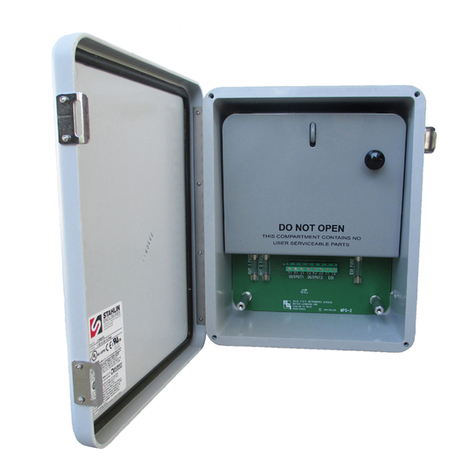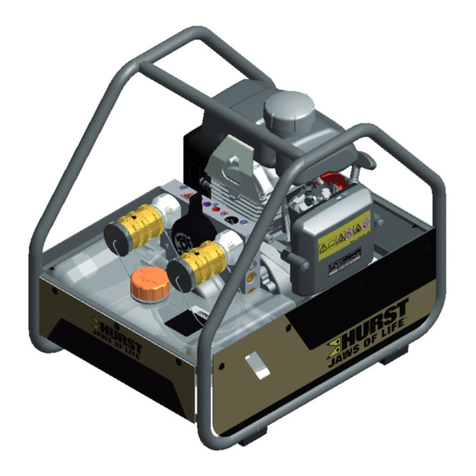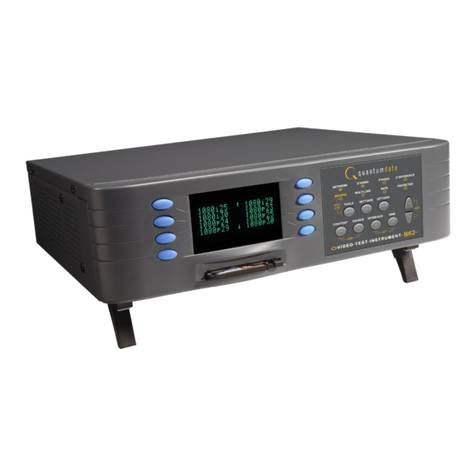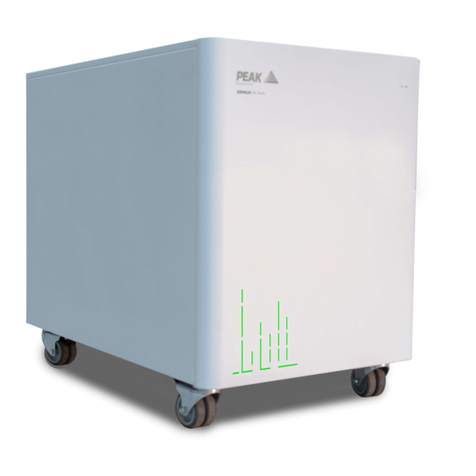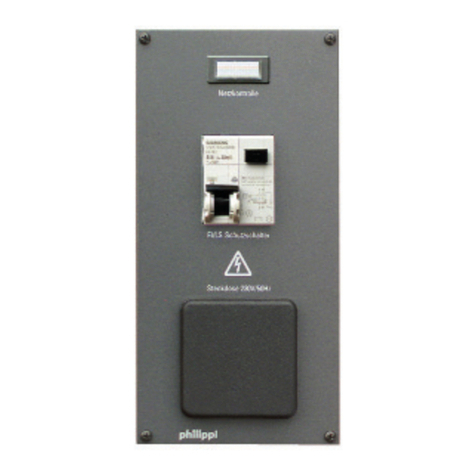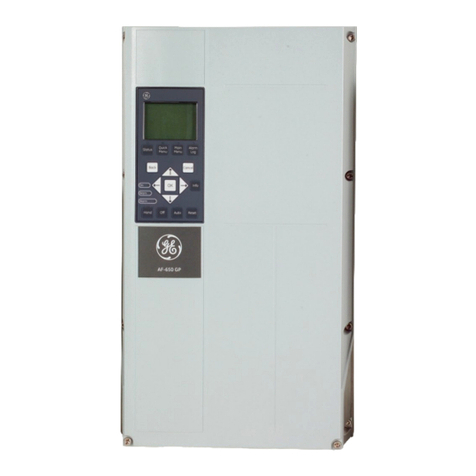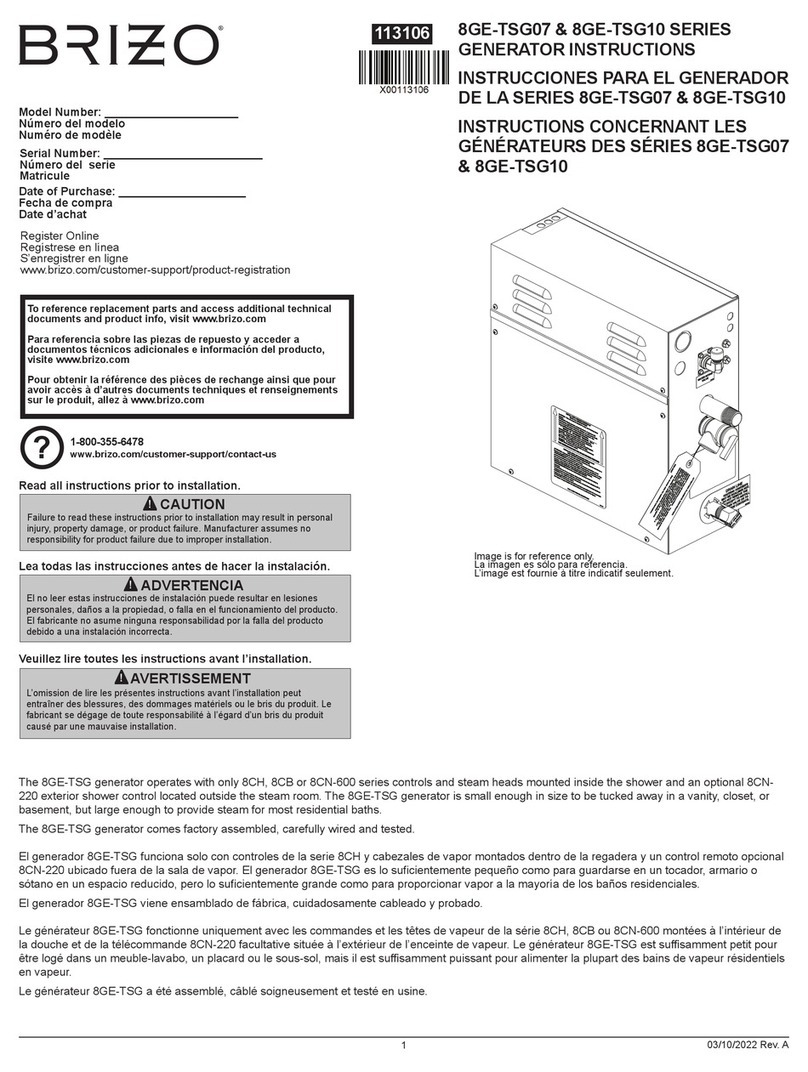SSI MPG-1C User manual

SOLID STATE INSTRUMENTS
a division of Brayden Automation Corp.
6230 Aviation Circle, Loveland, Colorado 80538
Phone: (970)461-9600 Fax: (970)461-9605
E-mail: support@solidstateinstruments.com
INSTALLATION INSTRUCTION SHEET
MPG-1C Metering Pulse Generator
NEU
120V
POWER SUPPLY
INPUT
MOUNTING POSITION - The MPG-1C can be mounted in any position. Two mounting holes are provided. The
MPG-1C must be mounted in a non-metalic enclosure or somewhere where it can receive the streaming wireless
information from the meter without interference. The MPG-1C must be mounted within about 75 feet from your
meter. Distances vary with building construction and proximity to the meter. For best results, mount asclose to the
meter as possible. The pulse output lines from the MPG-1C may be run longer distances, but the MPG-1C should
have uninterrupted access for best results. Choose a mounting location that will not have any metalic parts --
moving or stationary -- that can affect the RF field.
POWER INPUT - The MPG-1C is powered by an AC voltage of between 90 and 300 volts. For 120VAC, connect the
AC supply's "hot" wire to the L1 terminal. For 208 to 277VAC, connect the AC supply's "hot" wire to the L2 terminal.
Connect the NEU terminal to the AC supply's "neutral" wire. Connect GND to electrical system Ground. *** Use L1
or L2, but DO NOT use both at the same time.***
METER INPUT - The MPG-1C receives data from a Zigbee-equipped AMI electric meter that has been pairedwith a
RAVEn Zigbee USB receiver. The RAVEn USB receiver must be paired with the meter before it can be used. Once
paired & inserted into the USB port, the MPG-1C starts receiving demand information from the meter. (See Page 3.)
277V
GND
Revision: 4/22/2018 P/N: 05908-96107A
Y1K1
NEUL1L2 GND
Outputs
Use one power input ONLY plus Neutral
USB
Host
Port
USB HOST
PORT
OPERATION - See the following pages for a full explanation of the operation of the MPG-1C.
Y2K2Z1 Z2
OUTPUTS - Two 3-wire isolated outputs are provided on the MPG-1C, with output terminals K1, Y1 & Z1 and K2,
Y2, & Z2. Transient suppression for the contacts of the solid-state relays is provided internally. The output loads
should be limited to 100 mA at 120 VAC/VDC. Maximum power dissipation of each output is 800mW. The outputs
are protected by fuses F1& F2. One-tenth (1/10) Amp fuses (the maximum size) are suppliedstandard.
Z2
Y2
K2
Z1
Y1
K1
OUTPUT #2
OUTPUT #1
Zigbee USB
Dongle
Zigbee
Communication
Status LEDs
Output
Status LEDs Y
Z
USB
Port USB Device Port
to programming computer
V2.12 Firmware
USB
Communication
Status LEDs

MPG-1C Wiring Diagram
s
4/22/18 N/A
DATE ORIGINAL
LATEST REVISION
SCALE
JOB NO.
REVISIONS
NO. DATE DESCRIPTION
WHB
DRAWNCHECKED
MPG-1C Wireless Pulse
Generator
Wiring Diagram
Brayden Automation Corp./
Solid State Instruments div.
6230 Aviation Circle
Loveland, CO 80538
(970)461-9600
(970)461-9205 fax
www.solidstateinstruments.com
MPG-1CWiringDiagram.vsd
AMI
Electric
Meter
w/Zigbee
Radio K1
Z1
Y1
K2
Z2
Y2
Out 1
Out 2
MPG-1C
Wireless Pulse
Generator
Service
Entrance
To Line
1 32 NEU
To Loads
Wireless
Data - 75' max
USB
RAVEn
dongle
To EMS
To SCADA
120-277VAC
Power
Supply
Connections
120
277
NEU
GND
Host
Port
F1
F2

MPG-1C Wireless Meter Pulse Generator
MPG-1C Metering Pulse Generator.vsd
Pairing the RAVEn Zigbee Radio Receiver
The RAVEn is a USB Zigbee Receiver device that must be paired with a Zigbee-equipped AMI electric meter. Thismay be
accomplished either with the assistance of the utility or on their website if they have the processautomated. Thepairing
process, also known as "provisioning", varies from utility to utility and not all utilities provide Zigbee radio availability in their
meters. Contact your electric utility to find out how their pairing process is accomplished. The RAVEn must be powered to
be paired with the meter and must be within range of the meter, usually within 75 feet.
The Meter must be programmed with the RAVEn's MAC address and Installation ID code. By being "paired", the meter and
the dongle have created a "network". The RAVEn dongle knows that it can only receive and accept information from that
particular electric meter. See the RAVEn instructions for more information on pairing the RAVEn with an electric meter.
Before Powering the MPG-1C, install the RAVEn in the MPG-1C's USB [Type A] host port.
Set the MPG-1C's Settings
Set the MPG-1C's output pulse value, the multiplier, the pulse mode and the pulse timing by using the USB [Type B] Device
Port on the MPG-1C board. All system settings are now configured using the USB port. See "Setting up the Serial Port" on
Page 5.
Output Pulse Value
The Pulse Value is set using the Pcommand. The pulse value (PV) is the number of watt-hours that eachpulse isworth.
The MPG-1C can be set from 1 Wh to 99999 Wh per pulse. Select an appropriate pulse value for your application. A good
starting point is 100 Wh/pulse for larger buildings and 10 Wh/pulse for smaller buildings. You can adjust it up or down as
needed. Larger facilities will require a larger pulse value to keep from overranging the MPG-1C's registers.
Set the Output Pulse Mode
The MPG-1C has two output pulse modes, the 3-Wire (Form C) Toggle mode or the 2-Wire (Form A) Fixed mode. Use the
C1 command to select the FORM C Toggle mode. The toggle mode is the classic pulse output mode that emulates the
standard KYZ 3-Wire electric meter output. It toggles back and forth, to the oppositestate, eachtime a"pulse" is generated
by the MPG-1C. Even though there are three wires (K,Y, & Z), it is common to use K and Y, or K and Z, for many two-wire
systems that require or desire a generally symetrical 50/50 duty cycle pulse at any given time. The toggle mode is used for
systems that are doing demand monitoring and control and need regularly spaced pulses. If you are in FORM CToggle
output pulse mode, and your pulse receiving device uses only two wires, and the pulse receiving device only countsthe
closure as a pulse(not the opening also), then the 3-Wire pulse value must be doubled in the Pulse Receiving Device. Red
and Green Output LEDs show the output status. See additional information on Page 5.
Use the C0 command to select the FORM A Fixed mode. In the Fixed mode, only the K-Y output isused. This isthe
standard 2-Wire system where the output contact is normally-open until such time as a pulse is generated. When a pulse is
generated, the contact is closed for a selected fixed time interval in milliseconds. Form A mode is generally associated with
Energy (kWh) measuring systems.
Set the Fixed Mode Output Pulse Width (Closure Time)
If you are using the MPG-1C in the Fixed Mode, set the output closure time or pulse width, selectable at 25ms, 50mS,
100mS, 200mS, 500mS or 1000mS (1 second) using the W command.(See Page 9) Upon a pulse being generated, the K-Y
terminals of each output will close for the selected number of milliseconds and light the RED LEDonly. Thissetting applies
only to the Form A output mode, and does not affect the toggle output mode. Use the shortest closure timepossible that will
reliably receiving by the pulse receiving equipment, so as not to unnecessarily limit the output's pulse rate.
Power up the MPG-1C
Once the RAVEn has been inserted into the USB host port, power up the MPG-1C board. TheRED LED on the RAVEn
dongle may flash for up to 60 seconds while it is establishing communications with the meter. Once it hascompleted
establishing communications and creating a network with the meter, the RAVEn's RED LED will stay on continuously. If this
LED is not on continuously, the MPG-1C will not receive information from the RAVEn. If no valid communicationisreceived
from the RAVEn, the MPG-1C will reset it every 120 seconds (default reset time) trying to establish a connection. The RED
LED on the RAVEn MUST be lit continuously before moving on. If it is not, then it is not provisioned correctly withthe utility's
meter. Do not proceed until this step is successfully completed.

MPG-1C Wireless Meter Pulse Generator (con't)
Communication LEDs
Upon power-up, the YELLOW comm LED should light indicating that the RAVEn dongle is correctly inserted, initialized and
communicating with the MPG-1C's processor. Within about approximately 45 - 60 seconds, the GREEN comm LEDwill
blink each time a valid transmission is received from the meter. As long as valid transmissions are received by theRAVEn
dongle and successfully relayed to the MPG-1C's processor, the Green comm LED will blink about once every 8-9 seconds.
If the Green comm LED does not blink, that is an indication that the data transmissions from the meter are not being
received, may be corrupted, or in some manner are not valid transmissions. If the Green comm LED has been blinking
reliably every 8-9 seconds for some time, then stops for a while and then restarts again, this indicatesthat transmissions are
intermittent and sporatic, or generally means there is a problem in the RAVEn's ability to receive data reliably from the
meter. To correct this, change the proximity of the MPG-1C to the meter, move it closer to themeter if possible and
eliminate any metalic obstructions between the meter and the MPG-1C. Also check to make sure that any walls or barriers
between the MPG-1C and the meter have as little metal in them as possible. In some applications you may need line-of-
sight.
Pulse Outputs
Outputs can be configured to bein the Toggle (Form C) mode or the Fixed (Form A) mode. Generally speaking, the Form
C mode can be used with either 2-Wire or 3-Wire Pulse receiving devices, while the Form A mode uses only a 2-Wire
interface to the downstream (receiving) pulse device. The choice would depend on the application and the desired pulse
format that the receiving device preferstosee.
If the RAVEn is reliably receiving data from the meter and passing it on to the MPG-1C's processor, thenyou should see the
Red and Green output LED's toggle each time the selected pulse value is reached, and the processor generates a pulse. If
the pulse output value is too high and pulses are too slow, then select a lower pulse value using the Pcommand.
If pulses are being generated too rapidly, select a higher pulse output value using the Pcommand. The maximum number
of pulses per second in the toggle mode is approximately 10, which means that the output's open and closed times are
about 50mS each in toggle mode. If the calculation by the MPG-1C's processor is for pulse output timing that exceeds 15
pulses per second, the MPG-1C will light the RED comm LED, indicating an overflow error, and that the pulse value is too
small. It is "latched" on so that the next time you look at it this RED LED will be lit. In this way, youcan quickly determine if
a pulse output value is too small. In the optimum application, pulses would not exceed more than one or two pulsesper 8
seconds at full scale demand. This allows a very even and "normal" pulse rate that as closely as possible resembles an
actual KYZ pulse output from the meter.
The MPG-1C will "spread out" the pulses over the next 10 second period if a high enough watt-hour valueisreceived in a
transmission to require that more than one pulse is generated. For example, suppose you have the Output Pulse Value of
10 wh selected. The next 8 second transmission yields 24 wh have been used. Since 24 watt-hours exceeds the 10 watt-
hour setting, two pulses must be generated. The first 10wh pulse will be generated immediately. About 3-5 seconds later
the second 10wh pulse will be generated. The remainder of four watt-hours stays in the accumulated energy register (AER)
awaiting the next transmission and the energy value of that transmission to be added to the contents of the AER. Another
example: Assume 25 wh/p Output Pulse Value. Let's say the next transmission is for 130 watt-hours. 130 is greater than
25, so 5 pulses will be outtputted over the next 7 seconds, approximately one each 1.4 seconds (7 seconds/ 5 = 1.4
seconds). The remainder of 5 wh will stay in the AER awaiting the next transmission. Some trial and error may have to be
done for any particular building since pulse rates will change depending on maximum load.
Overranging the Output
As previously mentioned, if there are too many pulses calculated to be outputted in a 6-7 second interval than the MPG-1C
can generate given the timing constraints, the MPG-1C will light the RED Comm LED. In this situation, simply increase the
output pulse value using the Pcommand. This LED is intended to notify the user that some pulses have been lost and a
larger pulse value is needed. As load is added to a building over time, there is a greater likelihood that this may occur,
especially if the pulse value is small. Be sure to consider this if/when you add load to the building. If an error condition
occurs, set the Output Pulse Value for a Wh value that is double the current pulse value. Remember tochange the pulse
constant of your receiving device as well, since pulses will now be worth twice the value. Cycle power to the MPG-1C to
reset the RED Comm LED after increasing the pulse value.

WORKING WITH THE MPG-1C RELAY
OPERATING MODES: The MPG-1C Meter Pulse Generator allows the outputs to be
configured in either the "Toggle" or "Fixed" pulse output mode. In the Toggle mode, the
outputs alternate or toggle back and forth each time a pulse is generated. This is
synonomous with the classic 3-Wire Pulse metering and emulates the SPDT switch model.
Figure 1 below shows the timing diagram for the "Toggle" output mode. KY and KZ closures
or continuity are always opposite of each other. In other words, when the KY terminals are
closed (on), the KZ terminals are open(off). This mode is best for timing pulses to derive
demand whether 2 or 3 wires are being used.
Contact the factory for technical support at (970)461-9600.
In the Fixed output mode, shown in Figure 2 below, an output pulse (K-Y closure only) is a
fixed width (T1) each time the output is triggered. The pulse width (closure time) is
determined by the setting of the W command. This mode is best for energy (kWh) counting
systems but is generally not the best for systems doing demand control where pulses are
timed to derive instantaneous kW demand. The K-Z output is not used in the normal/fixed
mode. However, it is used in the Signed mode. See Page 6.
T1
Figure 2: 2-Wire Only FIXED Output Operation
K-Y Out Open
Closed
Open
Closed
K-Z Out
Figure 1: 2-Wire or 3-Wire TOGGLE Output Operation
K-Z Out
K-Y Out Open
Open
Closed
Closed
KY closure time
In Signed mode, with a Form A output mode selected, the K-Z output pulse represents
negative (or kWh received) energy. (See Page 6.)

MPG-1C Advanced Settings
MPG-1C Metering Pulse Generator.vsd
Meter Multiplier
If the building on which you are using the MPG-1C has an "Instrument-Rated" electric meter, AND the local utility has not
included this multiplier in the programming of the meter, you will have to enter the Meter Multiplier to the MPG-1C's
program. To check out whether or not this is needed, (assuming your RAVEn is paired with the electric meter) either
install the RAVEn on a computer in the building and look at the serial output using a terminal program, or hook up the
MPG-1C's serial port to a computer and view with a terminal program.
Determine the Multiplier of the facility's electric meter. If the meter is a self-contained meter, the multiplier is 1. The
default external multiplier in the MPG-1C is one (1), so you can skip this step. In an instrument-rated metering
configuration, the meter multiplier is normally the Current Transformer ("CT") ratio, but will also include the Potential
Transformer ("PT") Ratio, if PT's are used, usually only on larger applications. A 800 Amp to 5 Amp current transformer,
for example, has a ratio of 160. Therefore, the meter multiplier on a building with 800:5A CT'swould be160. The
Multiplier is normally printed on the monthly utility bill. If you cannot find it, call your utility and ask what the meter or billing
multiplier is.
If the utility's Zigbee transmission to the RAVEn includes the correct CT/PT multiplier value, you can skip this step also.
This is very rare on instrument-rated metering implementations however, since most utilities donot want toprogram the
multiplier into the meter due to conflicts with the billing process. If you are looking at the serial data received from the
meter you will be able to see what internal multiplier is being sent in every transmission. This will be in hexidecimal
format. What you're looking for is whether this is 1 or something else besides one. If, for instance, the multiplier isa
decimal 160, it will be transmitted by the meter to the RAVEn as a hexidecimal "A0". If the multiplier is one(1), you then
know that either this is a self-contained meter and a multiplier of 1 iscorrect, OR that this is an instrument-rated meter and
the utility does NOT send the CT/PT multiplier as part of the Zigbee transmission. If the latter istrue, (and this is the
standard), you will have to program the meter multiplier into theMPG-1C.
Setting up the Serial Port
Connect the USB A-B Type serial cable to the computer's USB port. Connect the other end to the MPG-1C's USB Type B
connector. With TeraTerm, Puddy, ProComm or some similar terminal program, select the correct COM port to be used,
set the baud rate at 57600 and the terminal mode Receive as CR+LF. Also make sure that the local echo is enabled or
"ON".
Turn on power to the MPG-1C and after the initialization process, the RED LED on the RAVEn should be lit continuously.
Assuming that the RAVEn is paired with the meter, is on, and is within 75' of the meter, thenevery 8 to 10 seconds, you
will see the following serial information receivedfrom the MPG-1C:
-----------------------
Time Stamp: 21582e64
Demand: 000967
Multiplier: 00000001
Divisor: 000003e8
Energy (U): 5.35 Wh
Energy (F): 5.70 Wh
-----------------------
If the multiplier coming from the meter is1 AND you know that the meter's multiplier is something other than one, you will
have to program the correct multiplier into the MPG-1C so that the true energy value iscorrect.
Programming the Multiplier
To change the multiplier in the MPG-1C, use the Mcommand. Enter M160 and press <Enter> to change the multiplier to
160, as outlined in the application above. The USB serial link to the MPG-1C will return:
----------------------------------------
Multiplier: 160
----------------------------------------
You will not see the "M160" that you typed in on the screen unless the local echo is enabled on your terminal software. To
read back what the value of the multiplier currently in the MPG-1C is, press R and <Enter>. The USB serial link will return
the current multiplier stored in the MPG-1C, along with all other system settings. For example, "Multiplier = 40" will be
returned if the current multiplier is 40. Case does not matter. The maximum multiplier is 99999 and must be an integer
(whole) number.
The USB serial port is used for both monitoring and programming the MPG-1C. Therefore you have toenter your data
between 8 second serial outputs from the MPG-1C.

MPG-1C Advanced Settings(cont)
MPG-1C Metering Pulse Generator.vsd
Programmable Output Pulse Value
To set the Output Pulse Value, use the P command with a value of 1 to 99999. The default value of thisregister isten
(10) watt-hours per pulse.
Hook up the MPG-1C's USB device port to a computer and use a terminal program to program a pulse value. (See
"Setting up the Serial Port" on the previous page.
Programming the Output Pulse Value with a Specific Value
To change the output pulse value in the MPG-1C, use the Pcommand. Enter P1440 and press <Enter> for example to
change the output pulse value to 1440 watt-hours or 1.44 kWh per pulse. The maximum value is 99999. The USB serial
link to the MPG-1C will return:
------------------------------------------------
Pulse Value: 1440 watthours, (NV)"
------------------------------------------------
indicating that the value is 1440 watt-hours (1.44kWh) and it is storedin Non-Volatile memory.
Reading back all Programmable Parameters
To view the values of all programmable settings that are currently programmed into the MPG-1C, press Rand <Enter>.
The USB serial link will return the following:
--------------------------------------------
Multiplier: 1
Pulse Value: 1440 Watt-hours
Output Mode: Normal
Output Form: C
Dongle Mode: Normal
Reset Time: 120 seconds
Filter: Enabled
Filter Setting: 2 Samples
--------------------------------------------
Set Factory Defaults
If you find that you want to reset all parameters back to the factory defaults, simply press the Zkey and <Enter>. The
following parameters will default back to the factory settings asfollows:
Multiplier=1
Pulse Value: 10 Wh
Reset Time: 120 seconds
Viewing the Firmware Version
In the event that the label on the MPG-1C's microcontroller is lost or becomes unreadable, you can ask the MPG-1C what
firmware version it has in it wth the "V" command. Press V or v, then <Enter>and the serial link will returnthe following:
MPG V2.12
Dongle Readout Mode
There are two dongle readout modes available on the MPG-1C, Normal and Echo. The Normal Mode is thedefault and
shows you the time stamp, the demand, the multiplier and the divisor coming from the meter. The Normal mode isset by
entering D0 followed by <Enter>.
----------------------------------------
Dongle Model: Normal
----------------------------------------
The Echo mode allows you to view the entire transmission coming from the meter the way it isreceived by the MPG-1C's
microcontroller from the dongle in XML format. This mode may be useful in troubleshooting in the event of intermittent
transmissions from the meter. Enter a D1 followed by <Enter> to put the MPG-1C into theDongle Echo mode.
The serial link will respond with:
----------------------------------------
Dongle Model: Echo
----------------------------------------

MPG-1C Advanced Settings (cont)
Bi-Directional Energy Flow (Signed Mode)
If you have energy flowing in both directions in the case of distributed energy resourses (solar, wind, etc), the MPG-1C
can provide both positive and negative pulses. This is known as the Signed mode, meaning that "kWh Delivered" (from
the utility to the customer) is positive or forward flow, and "kWh Received" (from the customer to the utility) is negative or
reverse flow.
The Pulse Value Setting is the same for both positive and negative values.
To enter the functional or operational mode into the MPG-1C, use the S0 and S1 commands. Press S0 <Enter> to set the
MPG-1C in the Normal mode. Press S1 <Enter> to set the MPG-1C in the Signed mode. The serial link to the MPG-1C
will return "Output Mode: Signed". To read what mode the MPG-1C is currently in, press R <Enter>. The serial link will
return the mode stored in the MPG-1C. For example, "Output Mode: Normal" will be returned. Case doesnot matter.
Form C Signed mode - A positive energy value received from the meter is added to the positive Accumulated Energy
Register(+AER). Negative energy values received are ignored. Only Form C toggle pulsesare generated on the KYZ
output for Positive energy flow. See Figure 3 below.
Form A Signed mode - A positive energy value received is added to the positive Accumulated Energy Register(+AER). A
negative energy value received is added to the negative Accumulated Energy Register(-AER). When either register
equals or exceeds the Pulse Value setting, a pulse of the corresponding sign is outputted on the correct line. Pulses in this
mode are Form A (2-wire) "Fixed" only. K-Y pulses are Positive pulses and K-Z pulses are negative pulses. They share a
common K terminal on the output. Set the pulse value using the Pcommand. Set the pulse width using theW command.
See Figure 4 below.
T1
Figure 4: 2-Wire (FORM A) FIXED Output Operation
K-Y Out Open
Closed
Open
Closed
K-Z Out KY closure time
In Signed mode, with a Form A output mode selected, the K-Y output pulse represents
positive (or kWh delivered) energy; K-Z output pulse represents negative (or kWh received)
energy.
(Positive)
(Negative)
Figure 3: 3-Wire (FORM C) TOGGLE Output Operation
K-Z Out
K-Y Out Open
Open
Closed
Closed
Positive Energy Pulse Outputs Only
Positive and Negative Energy Pulse Outputs
In Signed mode, with a Form C output mode selected, the K-Y and K-Z output pulses
represent positive (or kWh delivered) energy; Negative (or kWh received) energy is ignored.
Positive Flow Positive FlowNegative Flow
Positive Flow Positive FlowNegative Flow

Filter Mode Enable/Disable (F)
The MPG-1C includes a filtering mode to smooth out the erratic communications from the electric meter which happen for a
number of reasons. This mode allows you to use 2 to 10 samples, each at about 8 seconds long, to average usage, and
thus kW demand, over the selected interval from approximately 16 to 80 seconds. Depending on the device receiving the
pulses and the methodology it uses to interpret them, this can be a great help in representing thereal kW demand and
eliminate the quantitization problem caused.
To enable the filter mode enter Fx and <ENTER>. x is the number of samples used by the Filter Mode filteringthe energy
value over a desired number of samples, from 2 to 10. The default is 2. Enter F2, and the filter mode isenabled using2
samples. The serial link on the MPG-1C will return the following:
----------------------------------------
Filter: Enabled
----------------------------------------
To disable the filter mode enter F0 and <ENTER>. The serial link on the MPG-1C will return the following:
----------------------------------------
Filter: Disabled
----------------------------------------
XML Dongle Reset
V2.11 Firmware implemented a XML Dongle reset feature that will reset the dongle if the dongle received a pre-defined
number of transmissions at a rate less than 5 seconds. The "X" or "x" command is followed by a number from 2 to 10. A
X0<CR> command will disable the reset feature. The default number of time delay violations is 2.
List of MPG-1C Commands (?)
For help in selecting or using the serial commands with the MPG-1C, simply press the ? key. Theserial link on the MPG-1C
will return a full list of thecommands.
mXXXXX<CR> or MXXXXX<CR> - Set multiplier (XXXXX is 1 to 99999).
pXXXXX<CR> or PXXXXX<CR> - Set pulse value, Watt-hours (XXXXX is 0 to 99999)
tXXX<CR> or TXXX<CR> - Set Reset Time, seconds (XXX is 30 to 600).
'f0<CR>' or 'F0<CR>' - Disable Filter.
'fx<CR>' or 'Fx<CR>' - Enable Filter and set number of samples x=2 to 10(default =2)
'r<CR>' or 'R<CR>' - Read Parameters.
's0<CR>' or 'S0<CR>' - Set into Normal mode (positive only with Form A or C set by DIP4)
's1<CR>' or 'S1<CR>' - Set into Signed mode (positive/negative with only Form A)
'd0<CR>' or 'D0<CR>' - Set into Dongle Normal mode
'd1<CR>' or 'D1<CR>' - Set into Dongle Echo mode
'z<CR>' or 'Z<CR>' - Set Factory Defaults
'v<CR>' or 'V<CR>' - Query Firmware version
'xz<CR>' or 'Xz<CR>' - XML Dongle Reset - set number of occurances to reset dongle, z=2 to 10 (default =2)
Pulse Output Mode (Form)
'c0<CR>' or 'C0<CR>' - Pulse Output Mode Form C Disabled (Form A Output Mode)
'c1<CR>' or 'C1<CR>' - Pulse Output Mode Form C Enabled (Form C Output Mode) (default)
Form A Pulse Width
'wX<CR>' or 'WX<CR>' - Pulse Width in Form A mode, milliseconds - 25 to 1000mS, 100mS default;
Form A Pulse Width Selections:
'w0<CR>' or W0<CR>' - 25mS Closure
'w1<CR>' or 'W1<CR>' - 50mS Closure
'w2<CR>' or 'W2<CR>' - 100mS Closure
'w3<CR>' or 'W3<CR>' - 200mS Closure
'w4<CR>' or 'W4<CR>' - 500mS Closure
'w5<CR>' or 'W5<CR>' - 1000mS Closure
Other SSI Portable Generator manuals
